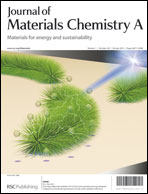A high capacity silicon–graphite composite as anode for lithium-ion batteries using low content amorphous silicon and compatible binders†
Abstract
In this study, silicon–graphite composites were prepared and investigated as anode materials for Li-ion batteries with small amounts of silicon and different binders. The silicon powders were prepared by ball-


 Please wait while we load your content...
Please wait while we load your content...